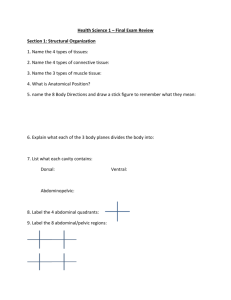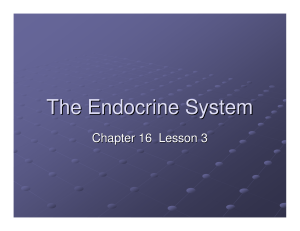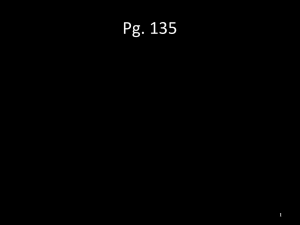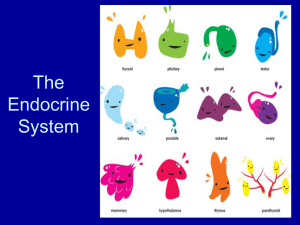Part B Review Guide Endocrine System (Pages 997
advertisement
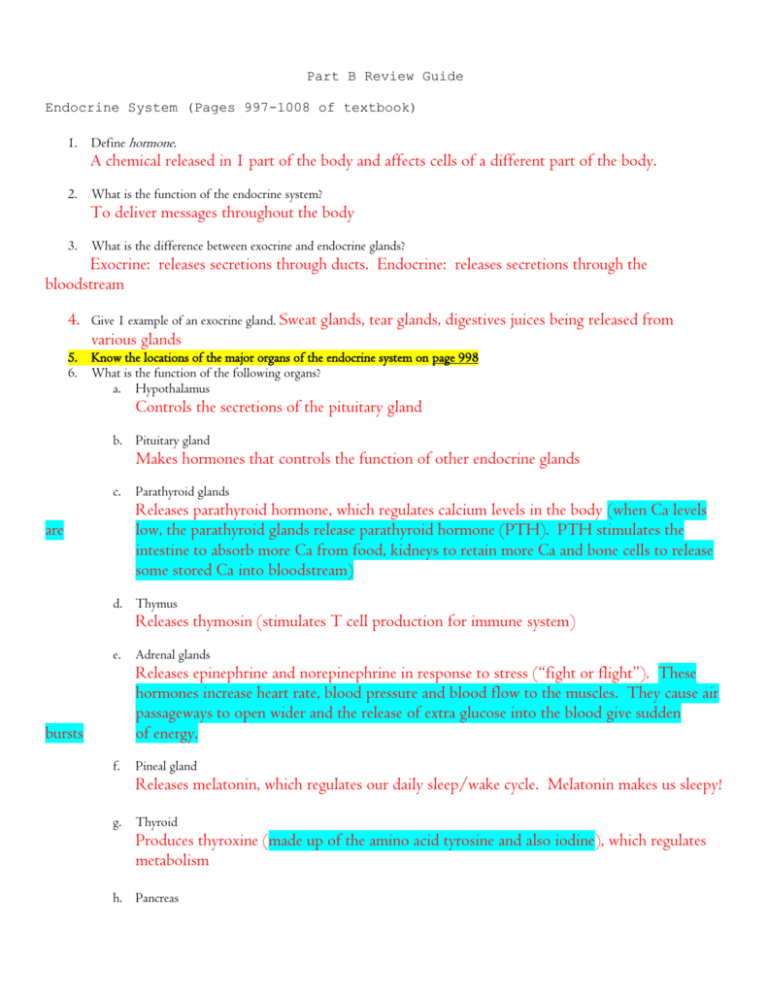
Part B Review Guide Endocrine System (Pages 997-1008 of textbook) 1. Define hormone. A chemical released in 1 part of the body and affects cells of a different part of the body. 2. What is the function of the endocrine system? To deliver messages throughout the body 3. What is the difference between exocrine and endocrine glands? Exocrine: releases secretions through ducts. Endocrine: releases secretions through the bloodstream 4. Give 1 example of an exocrine gland. Sweat glands, tear glands, digestives juices being released from various glands 5. 6. Know the locations of the major organs of the endocrine system on page 998 What is the function of the following organs? a. Hypothalamus Controls the secretions of the pituitary gland b. Pituitary gland Makes hormones that controls the function of other endocrine glands c. Parathyroid glands Releases parathyroid hormone, which regulates calcium levels in the body (when Ca levels low, the parathyroid glands release parathyroid hormone (PTH). PTH stimulates the intestine to absorb more Ca from food, kidneys to retain more Ca and bone cells to release some stored Ca into bloodstream) are d. Thymus Releases thymosin (stimulates T cell production for immune system) e. Adrenal glands Releases epinephrine and norepinephrine in response to stress (“fight or flight”). These hormones increase heart rate, blood pressure and blood flow to the muscles. They cause air passageways to open wider and the release of extra glucose into the blood give sudden of energy. bursts f. Pineal gland Releases melatonin, which regulates our daily sleep/wake cycle. Melatonin makes us sleepy! g. Thyroid Produces thyroxine (made up of the amino acid tyrosine and also iodine), which regulates metabolism h. Pancreas Releases insulin and glucagon, which both regulate blood sugar levels. Clusters of cells beta cells and alpha cells release these hormones (beta cells secrete insulin; alpha cells secrete glucagon). called i. Ovaries Produces estrogen (responsible for egg development and the formation of the physical characteristics associated with puberty) and progesterone (prepares uterus for pregnancy) j. Testes Produces testosterone (sperm production and the formation of the physical characteristics associated with puberty) 7. Which gland is considered part of both the endocrine and digestive systems? 8. Explain how the thyroid gland maintains homeostasis. 9. Explain how the pancreas maintains homeostasis. pancreas The hypothalamus senses low thyroxine levels in the body. It secretes thyrotropin releasing hormone (TRH). TRH stimulates the pituitary gland to secrete thyroid stimulating hormone (TSH). This prompts the thyroid to release more thyroxine. When blood sugar levels are too high, the pancreas secretes insulin. Insulin stimulates liver and muscles to store excess glucose as glycogen. When blood sugar levels are too low, the pancreas secretes glucagon. Glucagon stimulates liver and muscles to break down glycogen and release glucose back into the blood. Respiratory System (pages 956-963 of textbook) 1. What is the function of the respiratory system? Exchanges oxygen and carbon dioxide between blood, air and tissues. 2. Be able to identify the major organs of the respiratory system on page 957. 3. What is the function of each of the following organs? a. Nose and mouth Warms, moistens and filters the air we breathe in. b. Epiglottis Covers the entrance to the trachea when we are swallowing c. Pharynx (throat) Passageway for food and air d. Larynx (voicebox) Muscles pull vocal cords together and air moving between them produces sound e. Trachea (windpipe) Takes in oxygen from the environment f. Lungs Essential respiratory organ g. Bronchioles Leads into the lungs from the trachea; branches out until it reaches alveoli h. Diaphragm Large, flat, thin muscle that is between heart and liver and is involved in breathing. 4. Where does gas exchange take place? In the alveoli (air sacs), which are grouped into clusters that look like grapes; a delicate network of thin-walled capillaries surrounds each alveolus. 5. Explain how the diaphragm moves when we inhale and exhale. When we inhale, the diaphragm moves down to open up the chest cavity; the rib cage rises. When we exhale, the diaphragm moves up to push air out of the lungs; rib cage lowers. Part C Review Guide Circulatory System (pages 943-948) 1. What organs does the circulatory system include? Heart, blood vessels and blood The heart is enclosed in a protective sac of tissue called the ___pericardium___________. The __septum____divides the left side of the heart from the right side of the heart. How many chambers does a human heart have? ___4___ The upper chambers are called the ___atria____and the bottom chambers are called the ___ventricles____. The heart functions as two separate pumps. The right side of the heart pumps blood from the heart to the lungs and is called the ____pulmonary_______circulation pathway. 7. Oxygen-rich blood from the lungs (where carbon dioxide was exchanged for oxygen) flows into the left side of the heart and is pumped to the rest of the body. This is called the _____systemic_________circulation pathway. **See Figure 1 and 2 on the next pages** 8. Blood that returns to the right side of the heart is oxygen-poor because____cells have already absorbed the oxygen____. The cycle starts again when this blood goes to the lungs. 9. Why are valves important in the heart? They keep blood moving through the heart in only 1 direction 2. 3. 4. 5. 6. 10. What are the 3 types of blood vessels in the circulatory system? Arteries, capillaries and veins 11. Complete the chart below: Type of blood vessel Function Artery Carries oxygen-rich blood from the heart to the rest of the body Capillaries Veins Brings nutrients and oxygen to cells; removes CO2 and waste from cells Returns oxygen-poor blood to heart from the body Other information Largest vessel; has thick walls; blood is oxygen-rich Smallest vessels; one-cell thick Contains valves to keep blood flowing toward heart; blood is oxygen-poor HOW THE HEART WORKS: Figure 1 Figure 2



